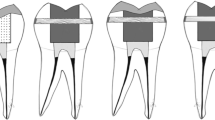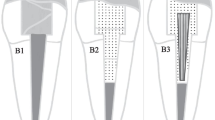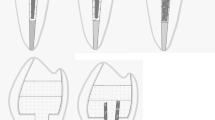Abstract
The aim was to explore the fracture-behavior, survival and marginal-microgaps within the root-canal of immature anterior teeth restored with different fiber-reinforced post-core composites (FRCs). 180 bovine-incisors were randomly divided into 6 groups (n = 30). One group served as control (group 6). The rest of the teeth were prepared to an internal diameter of 1.6 mm and the apex was sectioned. After application of an MTA-plug, teeth were restored with FRC materials: Group 1: Bioblock technique with short fiber-reinforced composite (SFRC); Group 2: Bioblock technique with flowable SFRC; Group 3: Individually-made FRC post; Group 4: Conventional FRC post; Group 5: dual-cure core build-up composite. After restorations were completed, teeth (n = 5/group) were sectioned and then stained. Specimens were viewed under a stereo microscope and the percentage of microgaps within the root-canal was calculated. Fatigue-survival was measured using a cyclic-loading testing machine in the rest of the specimens. Flowable SFRC application in the root-canal (Group 2) did not differ from intact-teeth regarding fatigue-survival (p > 0.05). The rest of the groups produced significantly lower survival (p < 0.05) compared to intact-teeth. Post/core restorations made from conventional FRC post (Group 4) exhibited a high number of microgaps (38.3%) at the examined interphase in the root-canal. The restoration of immature incisors with the use of flowable SFRC as post-core material displayed promising performance in a matter of fatigue-resistance and survival.






Similar content being viewed by others
References
O’Mullane DM. Injured permanent incisor teeth: an epidemiological study. J Irish Dent Assoc. 1972;18:160–73.
Ravn JJ. Dental injuries in copenhagen school children, school years 1967–1972. Community Dent Oral Epidemiol. 1974;2:231–45.
Wilkinson KL, Beeson TJ, Kirkpatrick TC. Fracture resistance of simulated immature teeth filled with resilon, gutta-percha, or composite. J Endod. 2007;33(4):480–3.
Andreasen FM, Andreasen JO, Bayer T. Prognosis of root-fractured permanent incisors: prediction of healing modalities. Endod Dent Traumatol. 1989;5:11–22.
Andreasen JO, Andreasen FM, Bakland LK, Flores MT. Traumatic dental injuries, a manual 2nd ed, vol. 9. Oxford: Blackwell Munksgaard; 2003. p. 58–60.
Witherspoon DE, Small JC, Regan JD, Nunn M. Retrospective analysis of open apex teeth obturated with mineral trioxide aggregate. J Endod. 2008;34:1171–6.
Schmoldt SJ, Kirkpatrick TC, Rutledge RE, Yaccino JM. Reinforcement of simulated immature roots restored with composite resin, mineral trioxide aggregate, gutta-percha, or a fiber post after thermocycling. J Endod. 2011;37(10):1390–3.
Jamshidi D, Homayouni H, Moradi Majd N, Shahabi S, Arvin A, Ranjbar Omidi B. Impact and fracture strength of simulated immature teeth treated with mineral trioxide aggregate apical plug and fiber post versus revascularization. J Endod. 2018;44(12):1878–82.
Cvek M. Prognosis of luxated non-vital maxillary incisors treated with calcium hydroxide and filled with gutta-percha. A retrospective clinical study. Endod Dent Traumatol. 1992;8(2):45–55.
Elnaghy A, Elsaka S. Fracture resistance of simulated immature roots using Biodentine and fiber post compared with different canal-filling materials under aging conditions. Clin Oral Investig. 2019. https://doi.org/10.1007/s00784-019-03014-8[Epub ahead of print] .
Linsuwanont P, Kulvitit S, Santiwong B. Reinforcement of simulated immature permanent teeth after mineral trioxide aggregate apexification. J Endod. 2018;44(1):163–7.
Garoushi S, Vallittu PK, Lassila LV. Continuous and short fiber reinforced composite in root post-core system of severely damaged incisors. Open Dent J. 2009;18(3):36–41.
Forster A, Sáry T, Braunitzer G, Fráter M. In vitro fracture resistance of endodontically treated premolar teeth restored with a direct layered fiber-reinforced composite post and core. J Adhes Sci Technol. 2016;31:1454–66. https://doi.org/10.1080/01694243.2016.1259758.
Fráter M, Lassila L, Braunitzer G, Vallittu PK, Garoushi S. Fracture resistance and marginal gap formation of post-core restorations: influence of different fiber-reinforced composites. Clin Oral Investig. 2019. https://doi.org/10.1007/s00784-019-02902-3[Epub ahead of print].
Lassila L, Keulemans F, Säilynoja E, Vallittu PK, Garoushi S. Mechanical properties and fracture behavior of flowable fiber reinforced composite restorations. Dent Mater. 2018;34(4):598–606.
Garoushi S, Vallittu P, Lassila L. Mechanical properties and radiopacity of flowable fiber-reinforced composite. Dent Mater J. 2019;38(2):196–202.
Lassila L, Säilynoja E, Prinssi R, Vallittu P, Garoushi S. Characterization of a new fiber-reinforced flowable composite. Odontology. 2019;107(3):342–52.
Scotti N, Coero Borga FA, Alovisi M, Rota R, Pasqualini D, Berutti E. Is fracture resistance of endodontically treated mandibular molars restored with indirect onlay composite restorations influenced by fibre post insertion? J Dent. 2012;40(10):814–20.
Le Bell AM, Tanner J, Lassila LV, Kangasniemi I, Vallittu P. Bonding of composite resin luting cement to fiber-reinforced composite root canal posts. J Adhes Dent. 2004;6(4):319–25.
Magne P, Lazari PC, Carvalho MA, Johnson T, Del Bel Cury AA. Ferrule-effect dominates over use of a fiber post when restoring endodontically treated incisors: an in vitro study. Oper Dent. 2017;42(4):396–406.
Lazari PC, de Carvalho MA, Del Bel Cury AA, Magne P. Survival of extensively damaged endodontically treated incisors restored with different types of posts-and-core foundation restoration material. J Prosthet Dent. 2018;119(5):769–76.
Fonseca RB, Haiter-Neto F, Carlo HL, Soares CJ, Sinhoreti MA, Puppin-Rontani RM, Correr-Sobrinho L. Radiodensity and hardness of enamel and dentin of human and bovine teeth, varying bovine teeth age. Arch Oral Biol. 2008;53(11):1023–9.
Reis AF, Giannini M, Kavaguchi A, Soares CJ, Line SR. Comparison of microtensile bond strength to enamel and dentin of human, bovine, and porcine teeth. J Adhes Dent. 2004;6(2):117–21.
Le Bell-Rönnlöf AM, Lassila LV, Kangasniemi I, Vallittu PK. Load-bearing capacity of human incisor restored with various fiber-reinforced composite posts. Dent Mater. 2011;27(6):e107–15.
Magne P, Carvalho AO, Bruzi G, Anderson RE, Maia HP, Giannini M. Influence of no-ferrule and no-post buildup design on the fatigue resistance of endodontically treated molars restored with resin nanoceramic CAD/CAM crowns. Oper Dent. 2014;39:595–602.
Tanalp J, Dikbas I, Malkondu O, Ersev H, Güngör T, Bayırlı G. Comparison of the fracture resistance of simulated immature permanent teeth using various canal filling materials and fiber posts. Dent Traumatol. 2012;28(6):457–64.
Garoushi S, Gargoum A, Vallittu PK, Lassila L. Short fiber-reinforced composite restorations: a review of the current literature. J Investig Clin Dent. 2018;9(3):e12330.
Bijelic-Donova J, Garoushi S, Lassila LV, Keulemans F, Vallittu PK. Mechanical and structural characterization of discontinuous fiber-reinforced dental resin composite. J Dent. 2016;52:70–8.
Fráter M, Forster A, Jantyik Á, Braunitzer G, Nagy K, Grandini S. In vitro fracture resistance of premolar teeth restored with fibre-reinforced composite posts using a single or a multi-post technique. Aust Endod J. 2017;43(1):16–22.
Ambica K, Mahendran K, Talwar S, Verma M, Padmini G, Periasamy R. Comparative evaluation of fracture resistance under static and fatigue loading of endodontically treated teeth restored with carbon fiber posts, glass fiber posts, and an experimental dentin post system: an in vitro study. J Endod. 2013;39(1):96–100.
Faria-e-Silva AL, Pedrosa-Filho Cde F, Menezes Mde S, Silveira DM, Martins LR. Effect of relining on fiber post retention to root canal. J Appl Oral Sci. 2009;17(6):600–4.
Grandini S, Goracci C, Monticelli F, Borracchini A, Ferrari M. SEM evaluation of the cement layer thickness after luting two different posts. J Adhes Dent. 2005;7(3):235–40.
Vallittu PK. Are we misusing fiber posts? Guest editorial. Dent Mater. 2016;32(2):125–6.
Belli S, Eraslan O, Eskitascioglu G, Karbhari V. Monoblocks in root canals: a finite elemental stress analysis study. Int Endod J. 2011;44(9):817–26.
Garoushi S, Säilynoja E, Vallittu PK, Lassila L. Physical properties and depth of cure of a new short fiber reinforced composite. Dent Mater. 2013;29(8):835–41.
Lempel E, Őri Z, Szalma J, Lovász BV, Kiss A, Tóth Á, Kunsági-Máté S. Effect of exposure time and pre-heating on the conversion degree of conventional, bulk-fill, fiber reinforced and polyacid-modified resin composites. Dent Mater. 2019;35(2):217–28.
Li X, Pongprueksa P, Van Meerbeek B, De Munck J. Curing profile of bulk-fill resin-based composites. J Dent. 2015;43(6):664–72.
Funding
This study belongs to and was supported by the research activity of BioCity Turku Biomaterials Research Program in Turku, Finland and by the UNKP-19-2 New National Excellence Program of The Ministry of Human Capacities, Hungary.
Author information
Authors and Affiliations
Corresponding author
Ethics declarations
Conflict of interest
Author Márk Fráter declares that he has no conflict of interest. Author Tekla Sáry declares that he has no conflict of interest. Author Viktória Néma Author declares that he has no conflict of interest. Author Gábor Braunitzer declares that he has no conflict of interest. Author Pekka Vallittu declares that he consults Stick Tech–Member of GC in training and RD. Lippo Lassila declares that he has no conflict of interest. Author Sufyan Garoushi declares that he has no conflict of interest.
Ethical approval
This article does not contain any studies with human participants or animals performed by any of the authors.
Additional information
Publisher's Note
Springer Nature remains neutral with regard to jurisdictional claims in published maps and institutional affiliations.
Rights and permissions
About this article
Cite this article
Fráter, M., Sáry, T., Néma, V. et al. Fatigue failure load of immature anterior teeth: influence of different fiber post-core systems. Odontology 109, 222–230 (2021). https://doi.org/10.1007/s10266-020-00522-y
Received:
Accepted:
Published:
Issue Date:
DOI: https://doi.org/10.1007/s10266-020-00522-y




